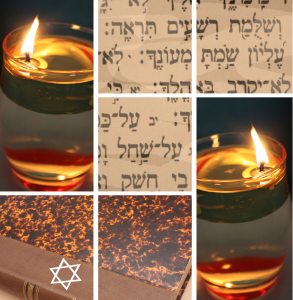Let’s begin by speaking about G-d’s giving of the Torah to the Jewish people at Mt. Sinai and its subsequent transmission.
It is our tradition that when G-d uttered the 10 commandments, He did not say one generic statement all of the Jews. This is what a teacher does in a classroom, aiming towards the middle of the class.
He, rather, miraculously conveyed the message of each commandment – to each and every Jew – at the exact level of understanding that he or she could fathom. In the words of the sages, His voice split into 600,000 voices based on each individual’s understanding. That means every level of Jew, from the simple child to the sage of profound intellect. This could be done because, like G-d is infinite, the Torah as the revelation of “G-d’s mind,” has infinite levels of understanding.
The entirety of Torah was transmitted with its myriad levels of meaning, from the simplest level to the most profound. Each letter and word of Torah is like a disk which contains reams of information to be played in the minds of the Jew studying it.
There is a level of perception befitting every Jew’s mind, understanding and abilities, to penetrate the depths of Torah.
The deepest of those levels, passed down by G-d at Sinai to Moses, is Kabbalah. Kabbalah is not an independent system of mystical thought which exists externally from Torah. It is, rather, the most profound level of understanding of the Torah, fulfillment of the mitzvos and G-d’s relationship to man and the world. It teaches the innate holiness of Man as created in the “Image of G-d” and all that is contained within that statement. It explains how Man is a microcosm of all that G-d created. It informs us of the cosmic impact we have upon the entire universe by our actions. This understanding greatly amplifies the importance of mitzvos by studying Torah and fulfilling the will of G-d, punctuating the ripple effect we create throughout the cosmos when we do so. It is very much part of Torah.
The bulk of Kabbalistic literature is based upon the magnum opus of Kabbalah, the Zohar. The Zohar, which means “the glow,” is a commentary to the Torah. It was written in Aramaic by the Mishnaic sage Rabbi Shimon bar Yochai, who lived after the destruction of the 2nd Temple in 70 CE. Rabbi Shimon, who is quoted profusely throughout the Mishna and Talmud, was one of the greatest sages in all Jewish history. All later Kabbalistic sages base their works on interpretations of the Zohar, which contains the foundations of Kabbalistic thought. There are other works of Kabbalah as well, but none that contain the breadth and detail of the Zohar.
The word “Kabbalah” means “the receiving,” referring to the way the Oral Torah was once transmitted, by word of mouth from Rebbe (master) to student. In fact, all of the Oral Torah was transmitted in this way; Moses himself “received” the Oral Tradition from G-d Himself at Sinai, which was called “Kabbalah.”
The reason this portion of the Torah is called “Kabbalah” more than the rest is because it was only handed down to a select few in each generation; those who were considered its most insightful sages and deemed worthy of receiving this profoundly deep body of knowledge.
Since R’ Shimon, the most recognized luminary of Kabbalah was the 16th century sage Rabbi Yitzchok Luria of Egypt and Safed, Israel. Known as the Ari z”l, the “Lion of blessed memory,” R’ Luria used his genius to develop the thoughts contained in the Zohar into a complete system, known as Lurianic Kabbalah. He revolutionized, and in many ways popularized, the study of Kabbalah, making it more understandable and at the same time revealed its intense profundity. He reinforced the tradition that only one deeply versed in the “revealed Torah” could possibly understand the “hidden Torah.”
Based on the Lurian teachings, many later Kabbalists developed introductory works, enabling students, who so desired, to have a path in beginning these studies. Some very good books have been written which filter down some of these concepts in a way that a layman can have some grasp of them. These were written by their authors with the hopes of enhancing the joy, depth and meaning of mitzvah observance by the Jewish people.
One needs to be very careful, however, as various cultish, charlatan organizations have sprung up in our generation which can be very misleading and often grossly misrepresent the true meanings of Kabbalah.
The Kabbalistic portion of the Torah is said to be hinted to in its entirety in the Image of the Chariot in the beginning of the Book of Ezekiel. I heard from my mentor in Jerusalem the reason for this; that the Kabbalistic teachings explain to us how the Almighty guides the world to be moving ahead, like a chariot, towards the final redemption.
Especially in our times, said to be the Ikvesa D’Moshicha, or the period of darkness immediately preceding the Messianic times, the Kabbalistic works have taken on a new level of importance and popularity, as we all seek light to offset the darkness of these times. I urge you to seek whatever Torah studies speak to and illuminate your heart. Like at Sinai, the Torah speaks specifically to every Jew at every level, and if you seek it, you will certainly find the area of study which speaks to you.
Sincerely,
Rabbi Yerachmiel Fried


